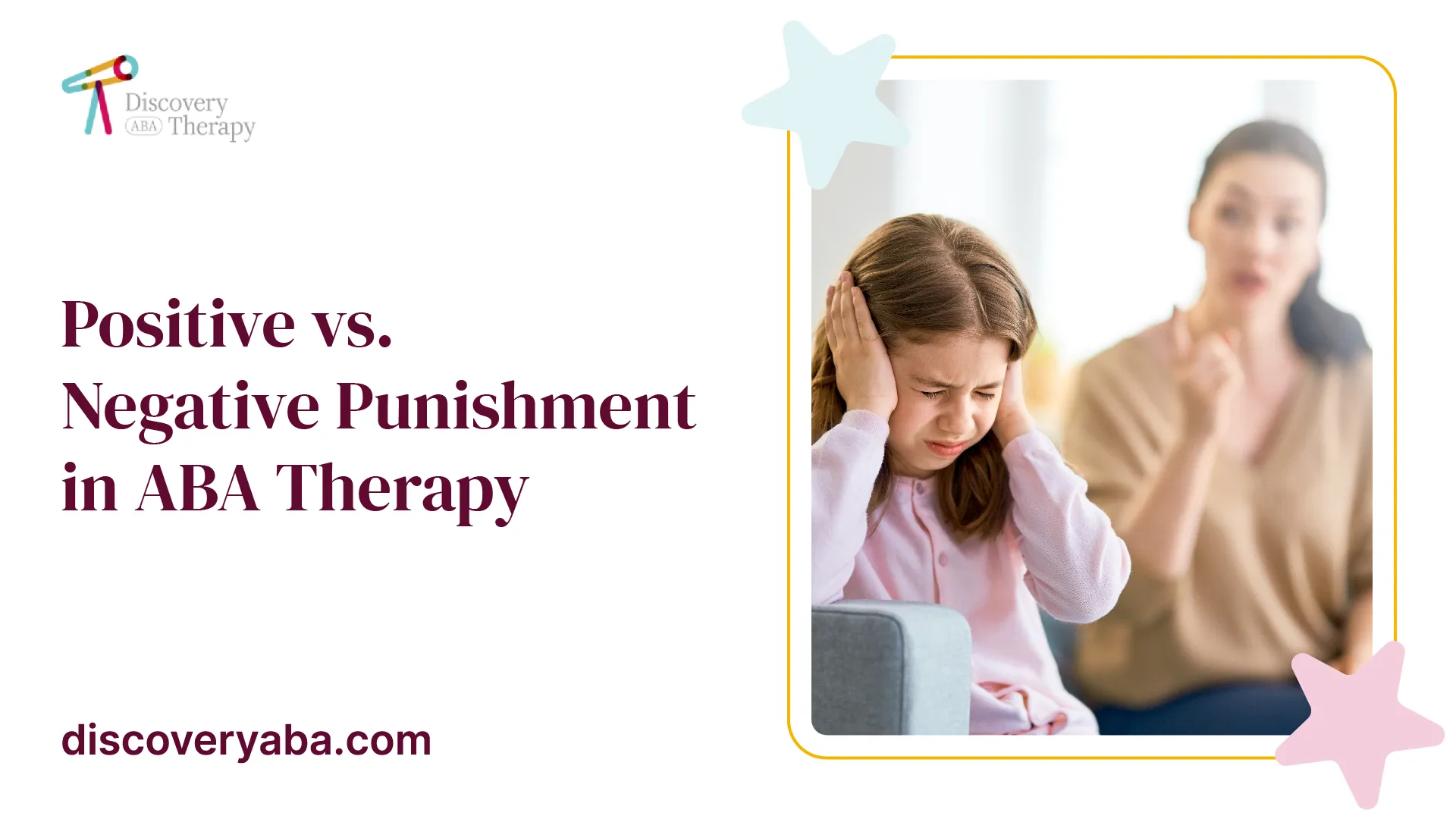Positive vs. Negative Punishment in ABA Therapy
Find out how positive and negative punishment are different in ABA therapy, and what's more effective.

Positive vs. Negative Punishment in ABA Therapy
There are several differences between positive and negative punishment in ABA therapy, as well as between positive and negative reinforcement in Applied Behavior Analysis.
Today we'll go over the most important differences, similarities, and how you can use positive and negative punishment to help children with autism improve social skills and behavior.

What is punishment in ABA therapy?
Punishment is a consequence that follows a behavior and decreases the likelihood of that behavior occurring again. Examples of punishment in ABA therapy include verbal reprimands, time outs, or withholding preferred items or activities.
Punishment should be used sparingly as it can create negative emotions for the child and disrupt the positive relationship between therapist and client.
What is positive punishment?
Positive punishment is the addition of an aversive stimulus following a behavior. An example of positive punishment in ABA therapy is verbal reprimands or time outs when behaviors occur.

Positive punishment can be effective for decreasing undesirable behaviors, but should be used sparingly as it can create negative emotions and disrupt the positive relationship between therapist and client.
What is negative punishment?
Negative punishment is the removal of a pleasant stimulus following a behavior. An example of negative punishment in ABA therapy would be withholding preferred items or activities when behaviors occur.

Negative punishment can also effectively decrease undesirable behaviors, but it too should be used sparingly as it can lead to frustration on behalf of the child and disruption of the positive therapist-client relationship.
Positive vs. Negative Reinforcement In ABA Therapy
Positive reinforcement is the addition of a stimulus after a desirable behavior occurs. This means that when the child performs a desired behavior, something rewarding is added to increase the likelihood of that behavior occurring again. Examples of positive reinforcement include social praise, edible treats, and tangible items such as toys or stickers.
On the other hand, negative reinforcement is the removal of an unpleasant stimulus following a desirable behavior. This increases the likelihood of this behavior occurring again in order to avoid becoming exposed to an unpleasant outcome. Examples of negative reinforcement in ABA therapy include removing instructions for difficult tasks or removing demands when requesting compliance from the child.
In both positive and negative reinforcement strategies, it is important for therapists to be aware of what motivates the child and to be consistent with their reinforcement schedules. This helps ensure that the desired behavior happens more often and is maintained over time.
Additionally, it is important for therapists to remember that reinforcement must follow closely after a desired behavior in order for it to be effective. Finally, when using reinforcement strategies, it is important to decrease the intensity of reinforcement over time as behaviors become stronger and more frequent.
Is positive punishment better than negative punishment in ABA therapy?
In general, positive reinforcement should be the primary strategy used when working with clients in ABA therapy. Positive reinforcement increases desirable behaviors and is more likely to lead to long-term behavior change than punishment strategies. However, there may be some instances where punishment strategies are necessary and appropriate.

In these cases, both positive and negative punishment can be effective but should always be used sparingly and only after other reinforcement techniques have been unsuccessful. It is important for therapists to carefully consider their use of any form of punishment in order to create a safe and positive environment for their client.
Examples of positive punishment in ABA therapy
Some examples of positive punishment in ABA therapy include verbal reprimands, time outs, or removing privileges.
Examples of negative punishment in ABA therapy
Examples of negative punishment in ABA therapy include withholding preferred items or activities when behaviors occur. Additionally, the removal of instructions for difficult tasks or demands when requesting compliance from the child can also be considered a form of negative reinforcement.
How to use positive punishment correctly in ABA therapy
When using positive punishment in ABA therapy, it is important to remember that these strategies should be used sparingly and only after other reinforcement techniques have been unsuccessful.
Additionally, any form of punishment should be closely linked with the behavior being targeted and follow quickly after the behavior occurs. Punishment should also only be used for a short period of time to prevent negative emotions associated with the process.
It is also essential that therapists focus on rewarding desirable behaviors in order to maintain a positive relationship with their client.
How to use negative punishment correctly in ABA therapy
When using negative punishment in ABA therapy, it is important to make sure that it follows closely after a behavior and is directly related to the behavior being targeted.
Negative punishment should also only be used for a short period of time to prevent the child from feeling frustrated or disconnected from the therapist. Additionally, it is important to focus on rewarding desirable behaviors in order to promote a positive relationship between therapist and client.
How to balance reinforcement and punishment in ABA therapy
A successful ABA therapy program should focus primarily on positive reinforcement while also incorporating punishment strategies as needed. It is important to ensure that a balance is maintained between these two techniques in order to create a safe and supportive environment for the client.
Additionally, it is essential to reward desirable behaviors in order to increase motivation and maintain a positive relationship with the client.
When should reinforcement and punishment be used in ABA Therapy?
Reinforcement and punishment should be used in ABA therapy when necessary, but should not be overused or relied upon as the primary strategy for behavior change.
Positive reinforcement should always come first and be used regularly to increase desired behaviors. Punishment strategies such as positive or negative punishment should only be used sparingly when necessary, and should always be closely linked with the behavior being targeted.
It is also important to ensure that a balance is maintained between these two techniques in order to create a safe and supportive environment for the client.
Pros and cons of punishment in ABA therapy
Punishment in ABA therapy can be effective, but comes with some potential risks and drawbacks. Positive punishment can help to decrease unwanted behaviors by providing an immediate deterrent from engaging in those actions again.
However, it is important to avoid using too much punishment which could lead to negative consequences such as resentment or aggression from the client. Negative punishment may also be effective in decreasing undesirable behaviors, but should only be used if other reinforcement techniques have been unsuccessful.
Additionally, it is essential to ensure that a balance is maintained between these two techniques in order to create a safe and supportive environment for the client.
Pros and cons of reinforcement in ABA therapy
Reinforcement in ABA therapy is beneficial because it can help to increase desirable behaviors, build a positive relationship between the therapist and client, and create an environment that encourages learning. However, reinforcement should not be overused or relied upon as the primary strategy for behavior change.
Additionally, it is important to ensure that a balance is maintained between reinforcement and punishment in order to create a safe and supportive environment for the client.
Conclusion
Overall, positive and negative reinforcement are two powerful tools used in ABA therapy to help increase desirable behaviors and maintain them over time. It is essential for therapists to remain consistent with their reinforcement schedule in order for these tools to work effectively. Ultimately, positive and negative reinforcement can provide children with structure, motivation, and an understanding of expectations within ABA therapy.
Does Your Child Have An Autism Diagnosis?
Learn More About How ABA Therapy Can Help
Find More Articles
Contact us
North Carolina, Nevada, Utah, Virginia
New Hampshire, Maine
Arizona, Colorado, Georgia, New Mexico, Oklahoma, Texas
.avif)




































































































